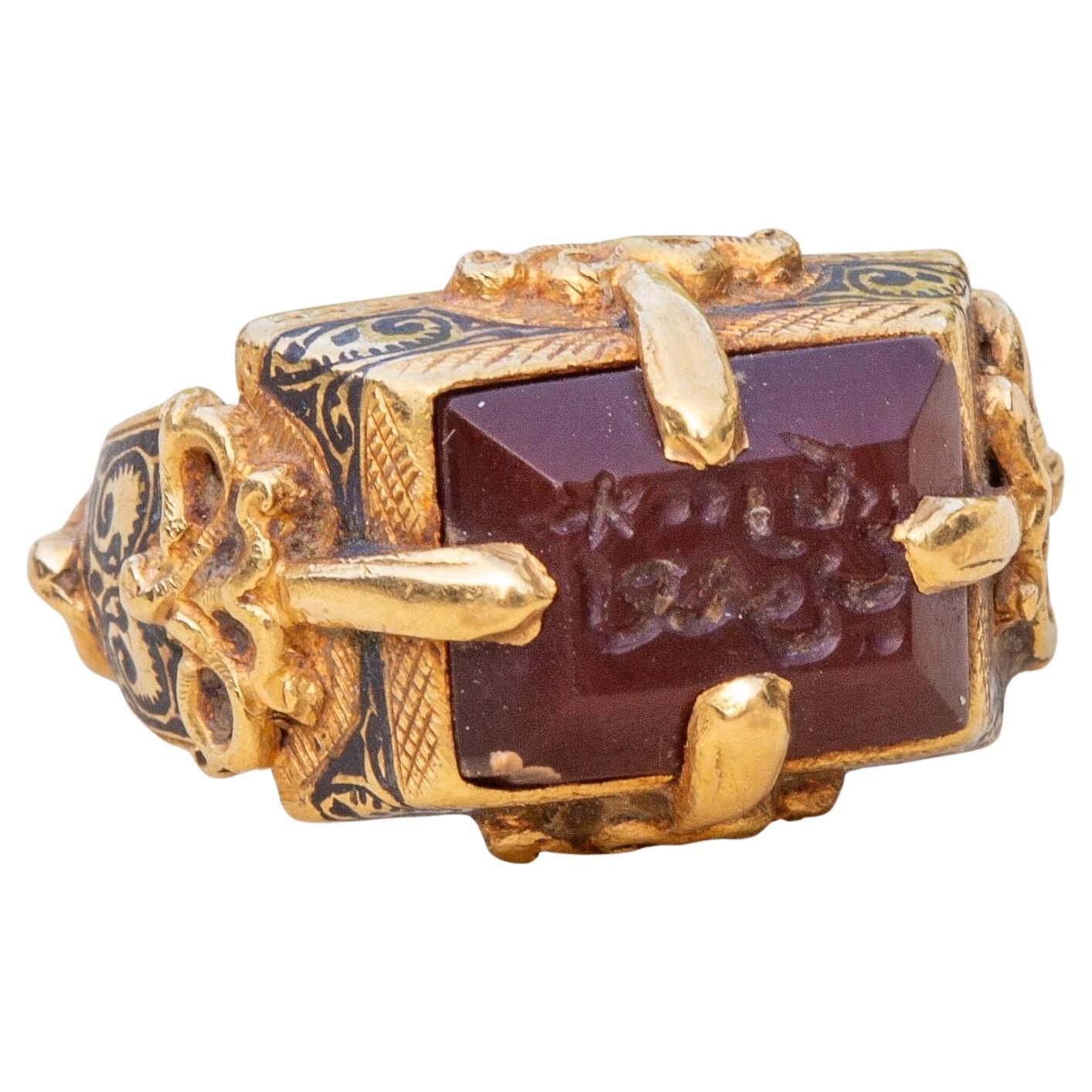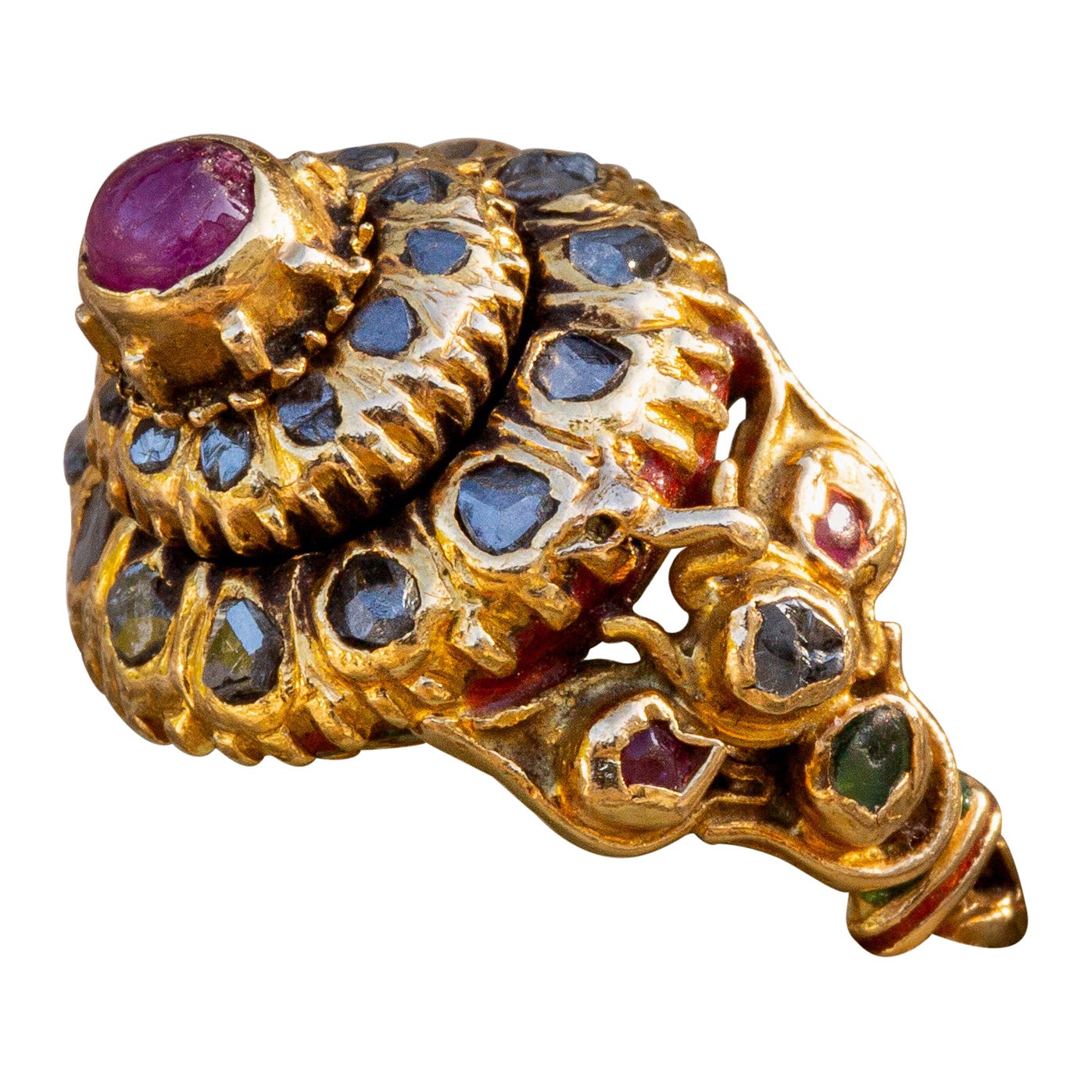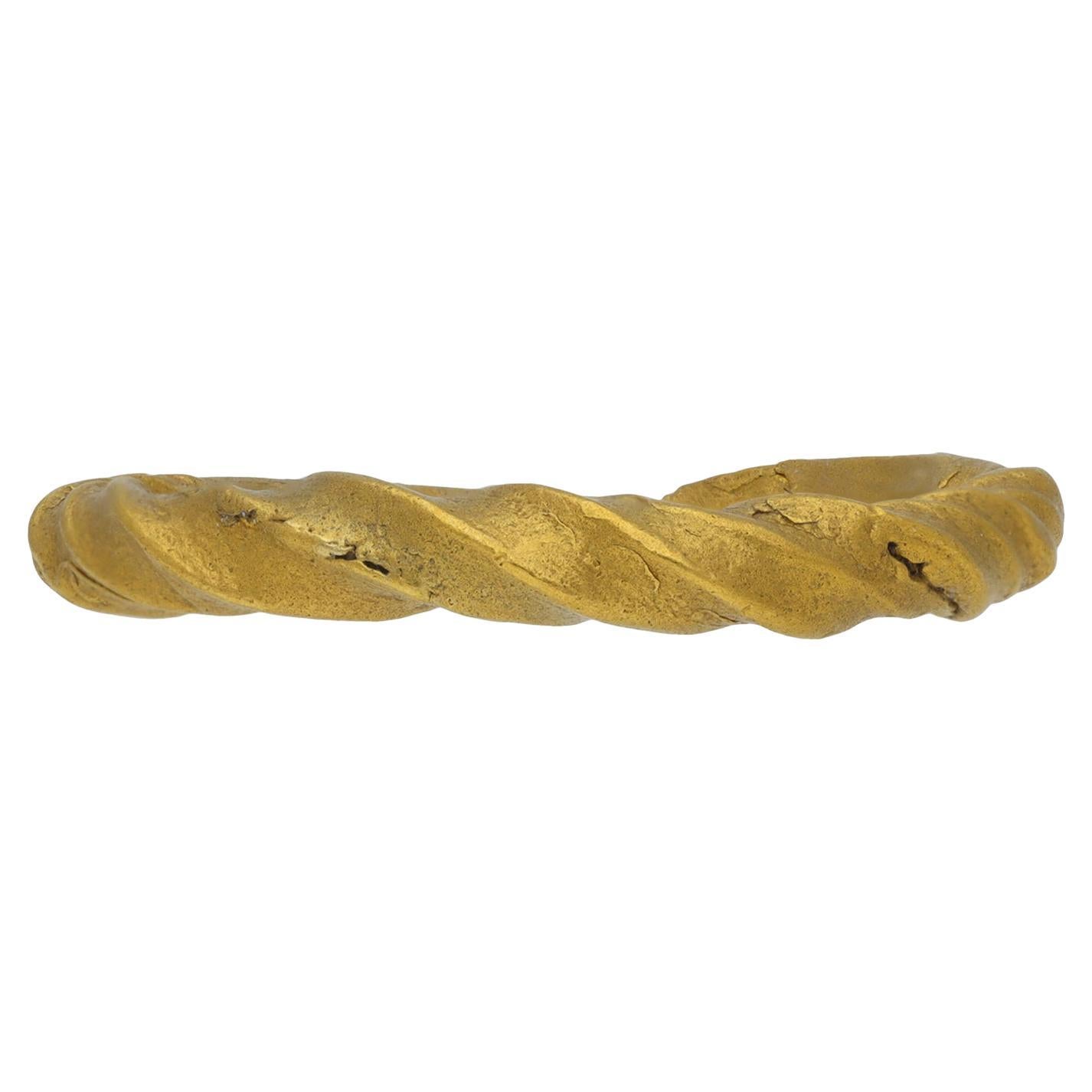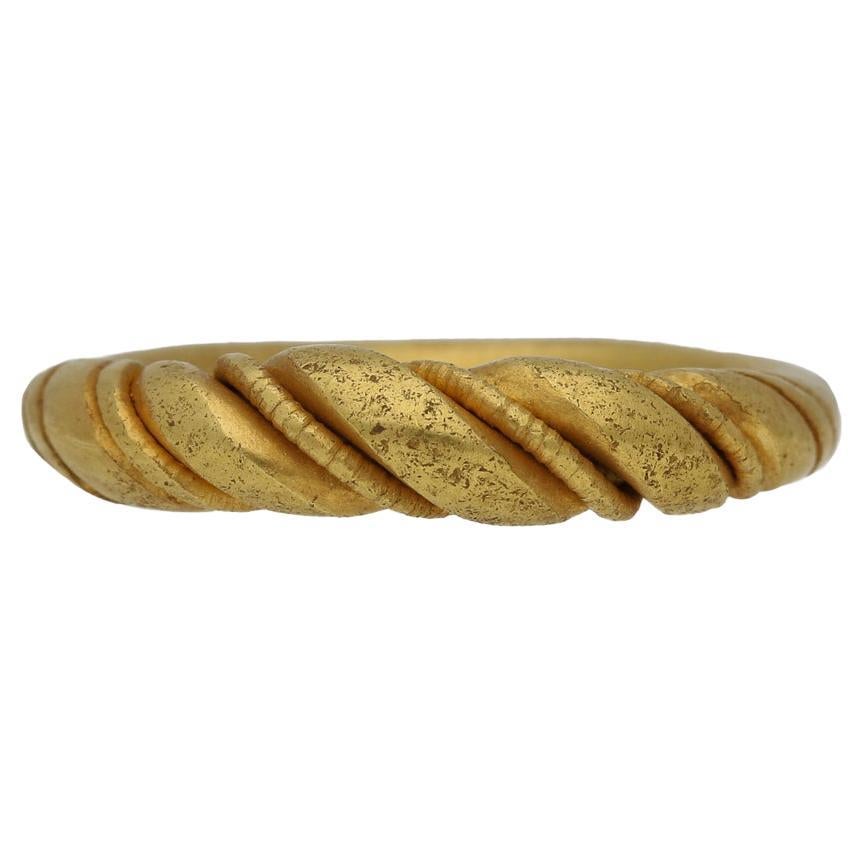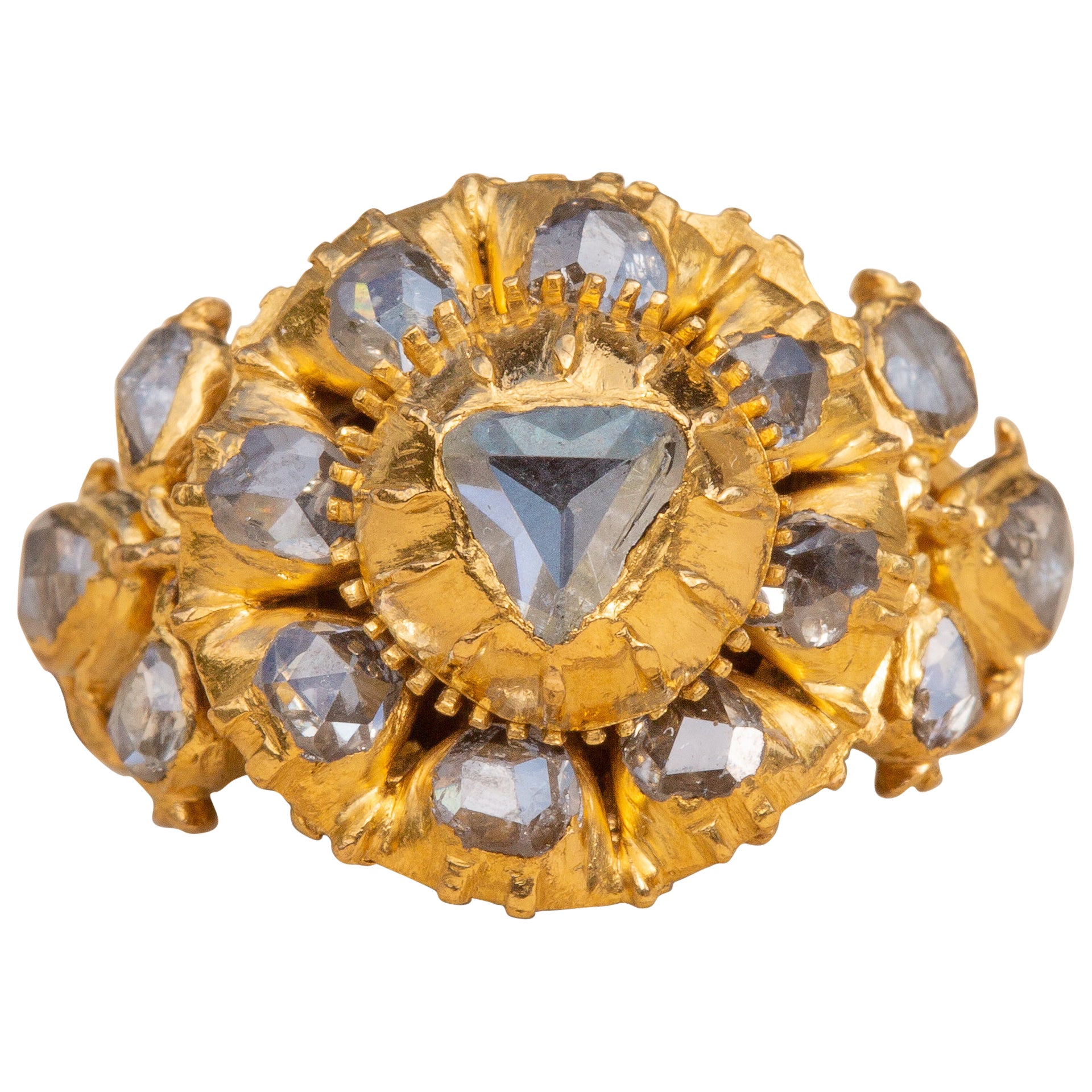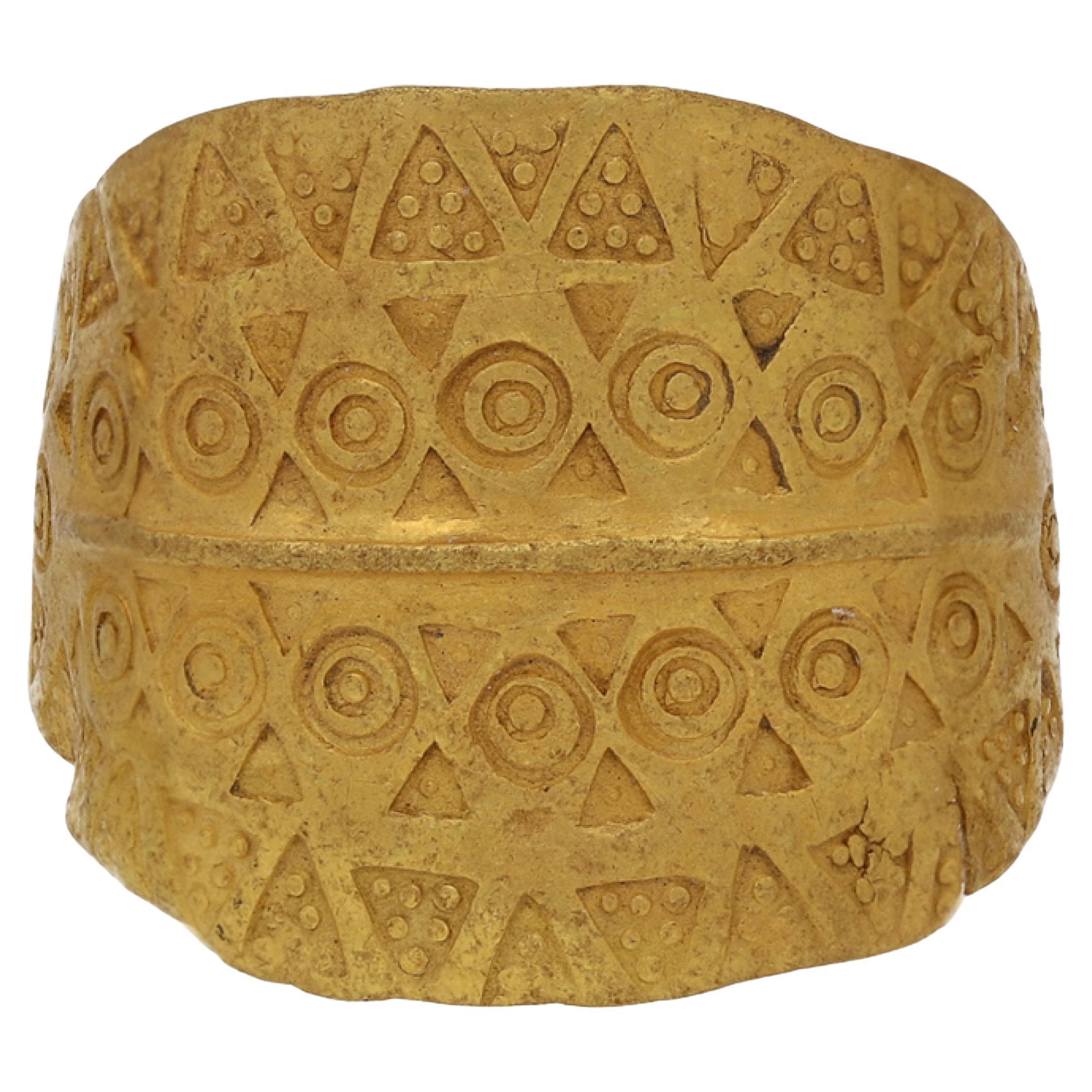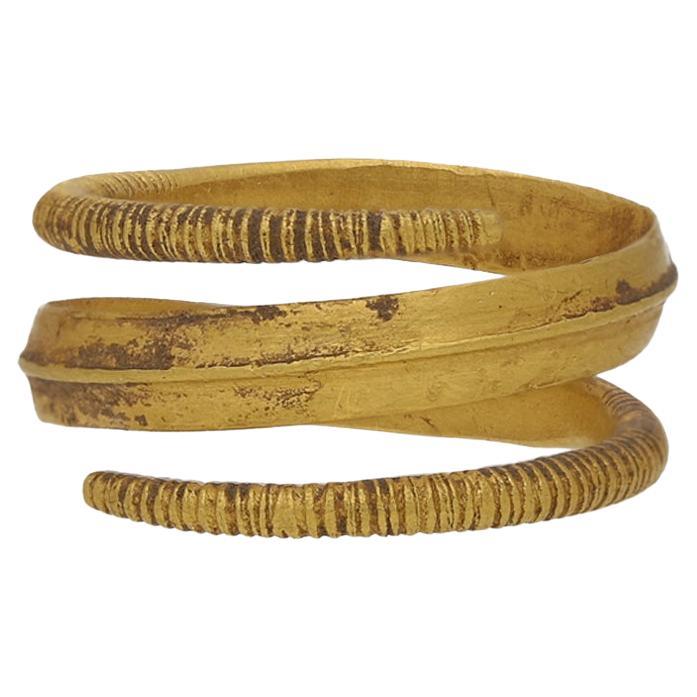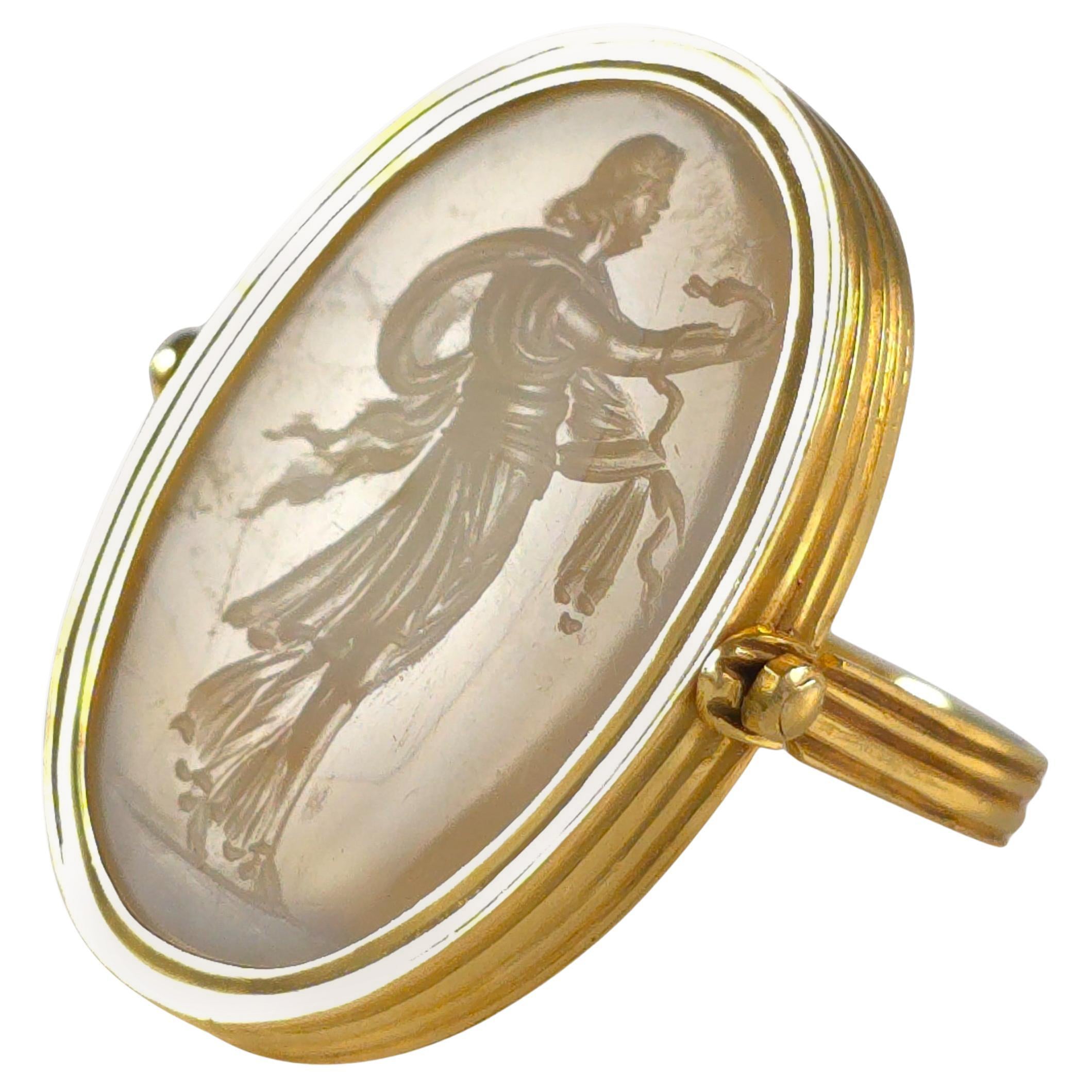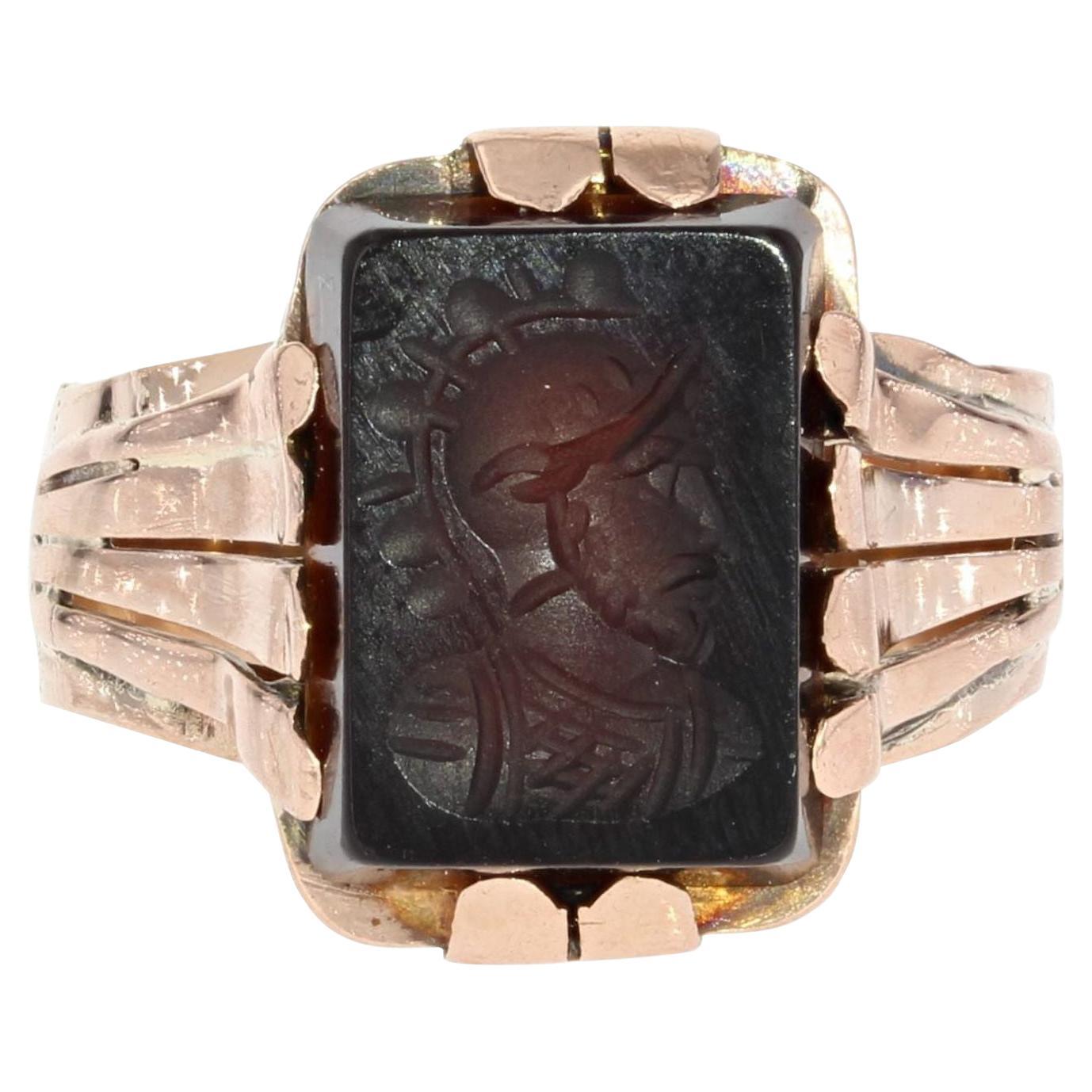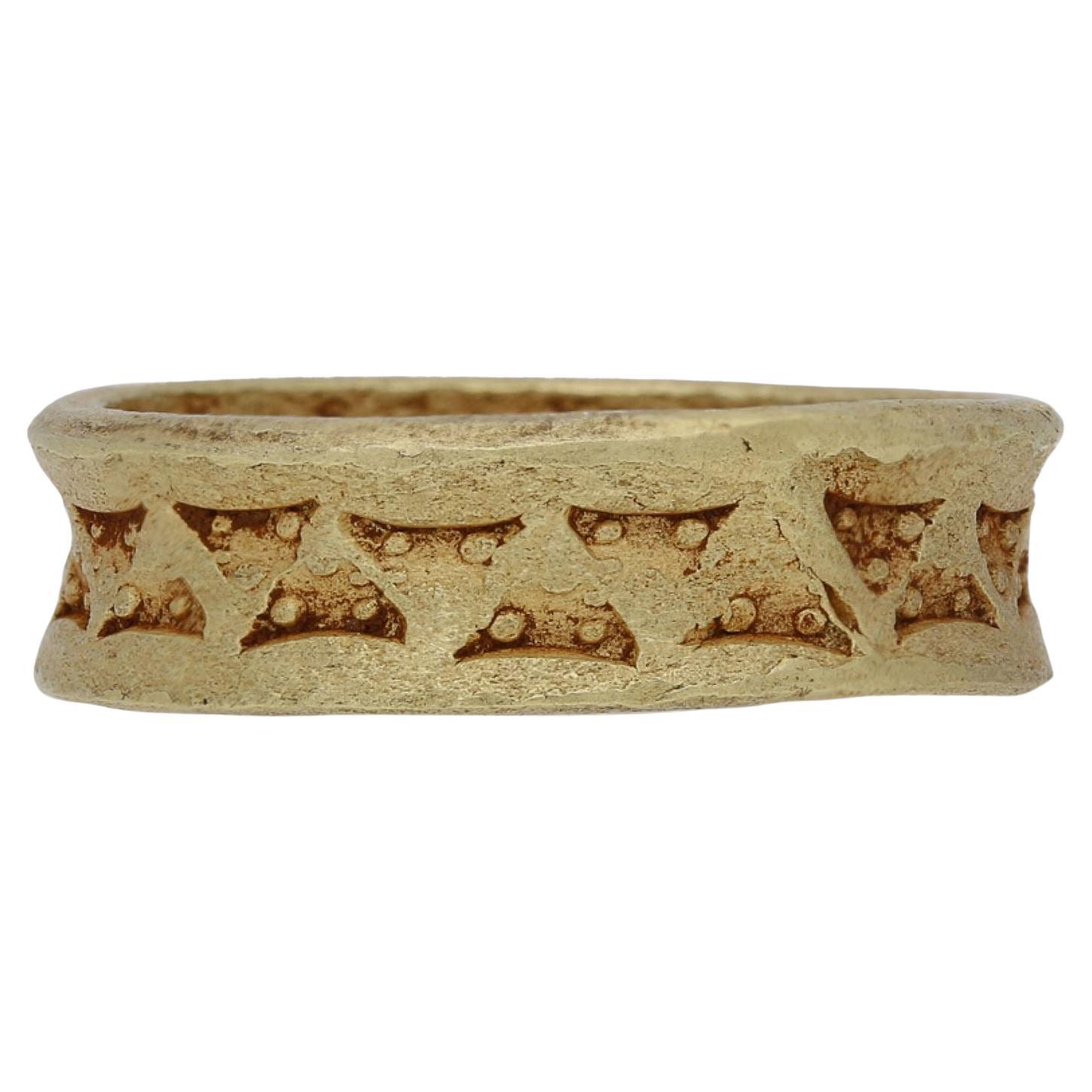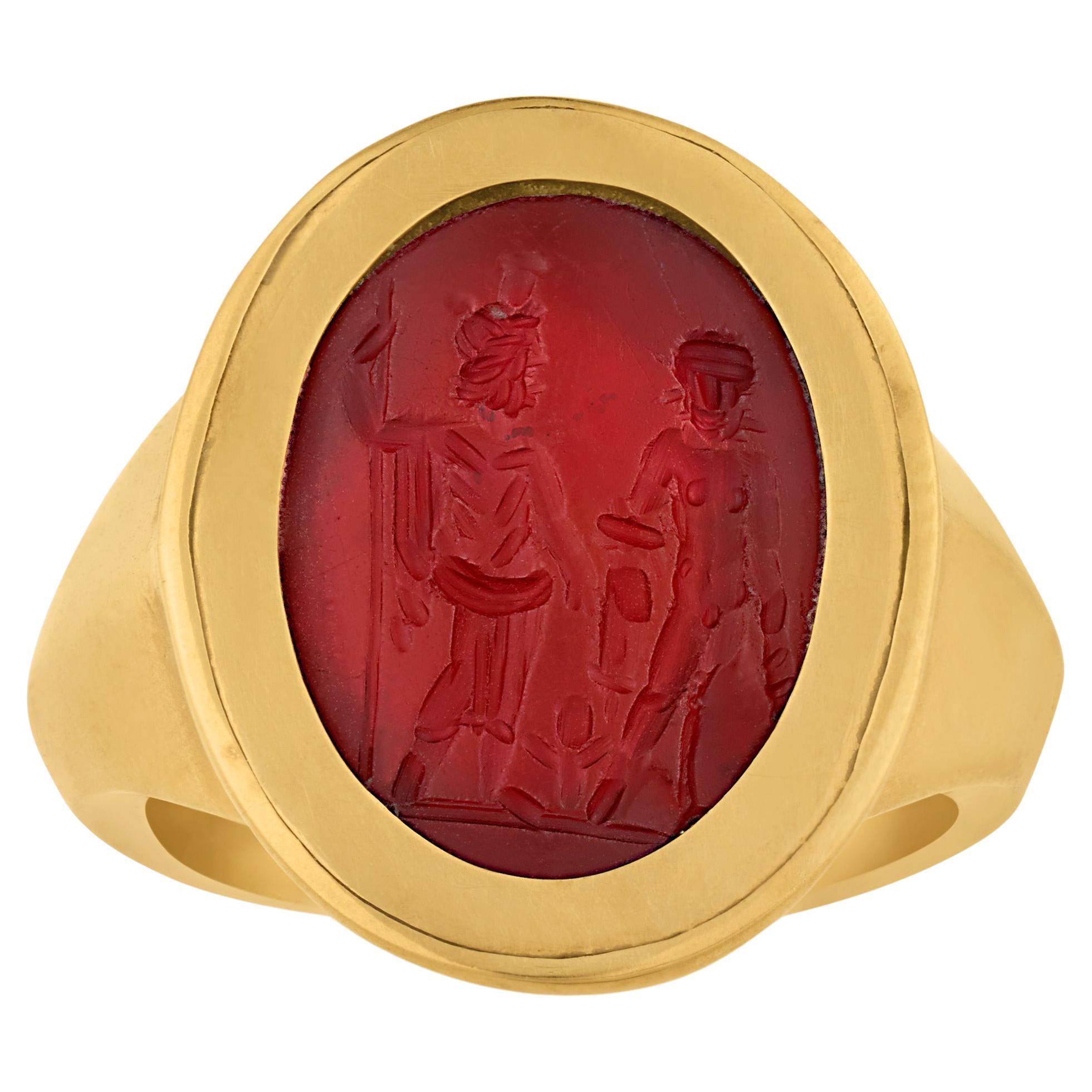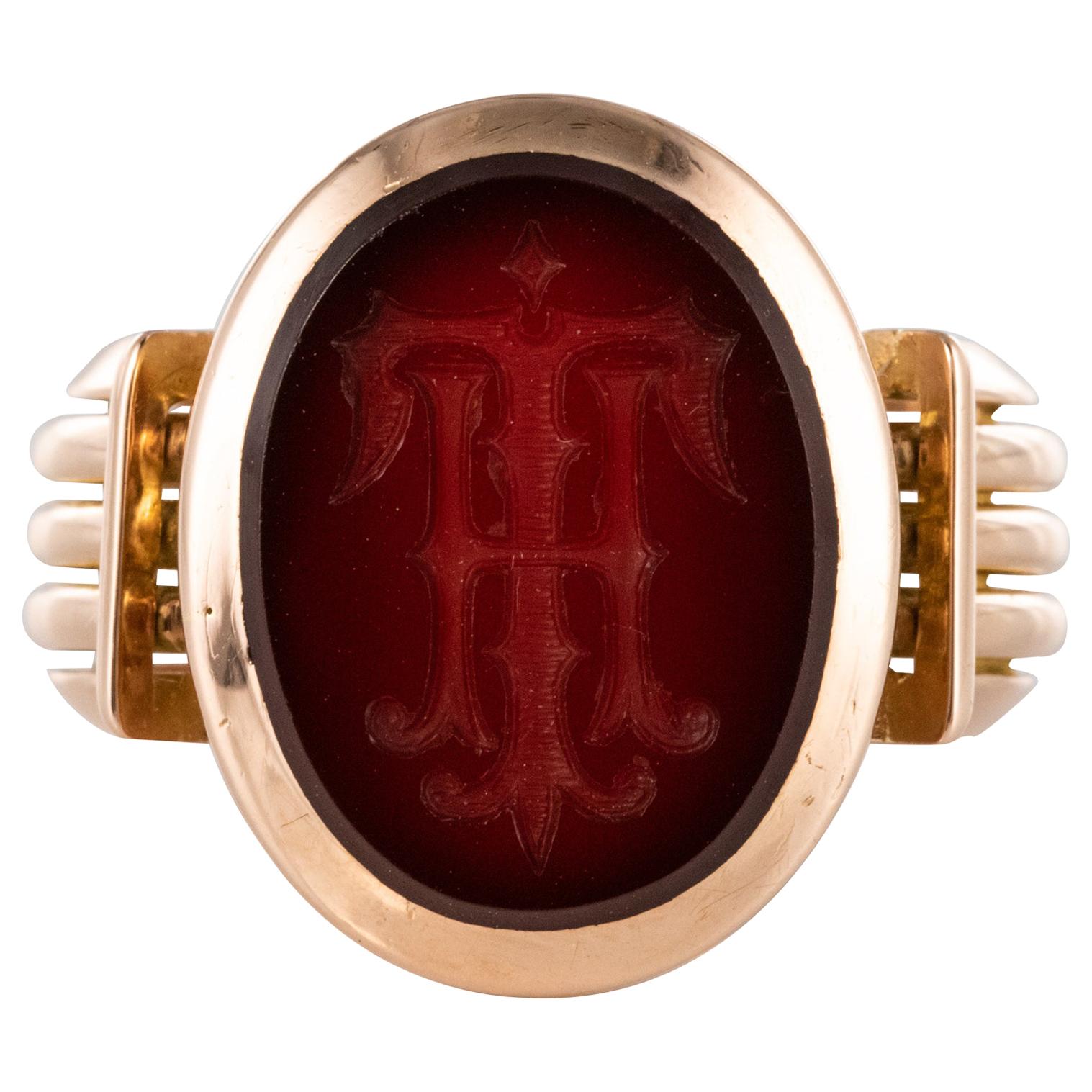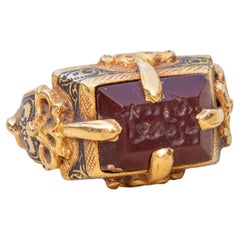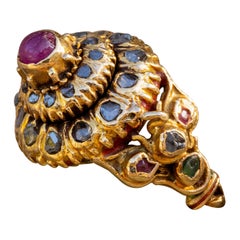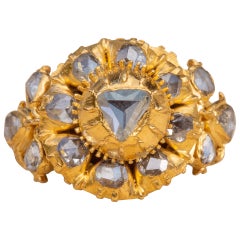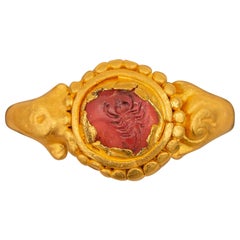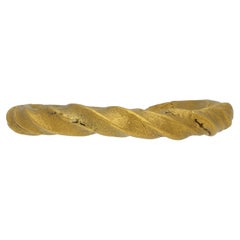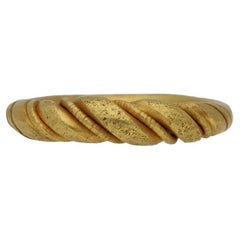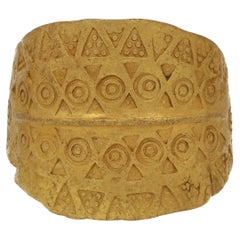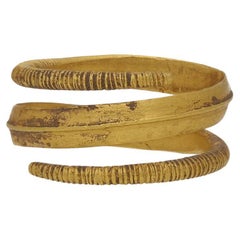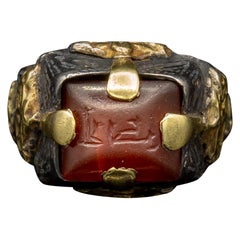
11th Century Seljuk ‘Selçuklu’ Dynasty Museum-Grade Islamic Intaglio Ring
View Similar Items
Video Loading
Want more images or videos?
Request additional images or videos from the seller
1 of 10
11th Century Seljuk ‘Selçuklu’ Dynasty Museum-Grade Islamic Intaglio Ring
$5,247.62List Price
About the Item
- Ring Size:4.75 US, Not Resizable
- Metal:
- Stone:
- Stone Cut:
- Weight:5.9 g
- Place of Origin:Iran
- Period:
- Date of Manufacture:1050
- Condition:Wear consistent with age and use.
- Seller Location:London, GB
- Reference Number:1stDibs: LU2845216742832
About the Seller
5.0
Vetted Professional Seller
Every seller passes strict standards for authenticity and reliability
Established in 2019
1stDibs seller since 2022
46 sales on 1stDibs
Authenticity Guarantee
In the unlikely event there’s an issue with an item’s authenticity, contact us within 1 year for a full refund. DetailsMoney-Back Guarantee
If your item is not as described, is damaged in transit, or does not arrive, contact us within 7 days for a full refund. Details24-Hour Cancellation
You have a 24-hour grace period in which to reconsider your purchase, with no questions asked.Vetted Professional Sellers
Our world-class sellers must adhere to strict standards for service and quality, maintaining the integrity of our listings.Price-Match Guarantee
If you find that a seller listed the same item for a lower price elsewhere, we’ll match it.Trusted Global Delivery
Our best-in-class carrier network provides specialized shipping options worldwide, including custom delivery.More From This Seller
View AllAntique Gold Seljuk 12th Century Ring Carnelian Intaglio Kufic Islamic Signet
Located in London, GB
This incredible, rare gold ring dates from the 12th century Seljuk dynasty. The carnelian intaglio is set within a typical Seljuk tapered rectangular bezel with a four-pronged gold setting soldered to the outside of the bezel. Applied and pierced arabesque designs are placed at the bottom of each prong which also reinforce the joints.
Further applied gold Seljuk ornamentation decorates the band, including two gold birds and a highly decorative vestigial sprued bottom (back-knob) from the casting. The gold mount itself is also ornately and intricately chased and nielloed with arabesque patterns. Remarkably, the niello work remains in exceptional condition, and can still be seen on the underside of the bezel which is decorated with a lattice pattern.
The carnelian intaglio seal is flat cut base with bevelled sides. This shape was predominantly used in the seals from the 8th to 11th century. The seal is engraved with angular Kufic script with forked terminals which dates the seal to the 9th-12th centuries (Porter, 2011).
For similar referenced examples in museums and notable collections, see final photos, in particular item 26 in ‘Islamic Rings and Gems: the Benjamin Zucker Collection’ (1987).
UK size K, US size 5.25
The ring weighs 9.19 grams and is crafted in high-karat gold (21K gold). The carnelian stone measures 11mm x 8mm x 3mm. The hollow box bezel measures 16mm x 10mm and protrudes 7mm from the base.
This museum-grade ring is a rare survivor, most existing examples have some damage to the ring, intaglio or niello - this is a scarce example in superb, original condition.
The Seljuks, a Turkish dynasty of Central Asian nomadic origins, became the new rulers of eastern Islamic lands following the defeat of the powerful Ghaznavids at the Battle of Dandanakan (1040). Under the Seljuk sultanate, which spanned from the 11th to the 13th century, goldsmiths and jewellers created works of unparalleled beauty and sophistication. Seljuk jewellery...
Category
Antique 15th Century and Earlier Engagement Rings
Materials
Carnelian, Gold
Royal Siam 'Thai' Museum-Grade 18th Century Ayutthaya Ceremonial Ring
Located in London, GB
This incredibly ornate piece was made in Siam during the late Ayutthaya or early Rattanakosin Kingdom period. It dates to the late 18th and is a very rare example of a ceremonial ‘mondop’ or ‘pagoda’ ring.
These rings were made for the monarchy and aristocratic class of Siam to be worn as part of the lavish adornment paraphernalia used in ceremonies. These elaborate rings were subsequently given as gifts to important visitors or other aristocratic families.
A similar example is found in Musée National du Château de Fontainebleau and was originally presented to Napoléon-III by the ambassadors of King Mongkut of Siam (Rama IV) alongside hundreds of other lavish gifts in order to re-establish diplomatic relations between France and Siam in 1861. Among these gifts are old jewels from King Mongkut’s treasury, including the gold diamond mondop/pagoda ring (see photos).
During this visit, the son of the Siamese ambassador, Khoumsombat, is photographed wearing a very similar tiered mondop ring with what also appears to be a ruby cabochon at the top (see photos).
A ‘mondop’ is the tiered roof of a temple, for example that of Wat Phra Kaew in Bangkok, and is designed to be in the shape of the image of Buddha. The top tier of this ring features a bezel set star ruby cabochon while the rest of the bezel is covered with diamonds. The two outermost tiers rotate and are connected to the main body of the ring with a bifurcated rivet visible on the closed-back underside of the bezel, typical ornamentation of 18th century layered cluster rings. The arched shoulders are equally as ornate with bezel set rub over diamonds, emeralds and rubies appearing between foliate motifs and protruding serpent-esque decoration. The underside and outershank display bright red and green floral enamelling often seen on naga rings...
Category
Antique Late 18th Century Thai More Rings
Materials
Diamond, Emerald, Ruby, 22k Gold
Important 19th Century Royal Siam Diamond Cluster Ring Museum-Grade Thai
Located in London, GB
An outstandingly rare mid-19th century royal Siam diamond cluster ring, made by the royal goldsmiths of the court of Bangkok.
This is an extremely fine example of the jewellery commissioned and subsequently bestowed by the Kings of Siam, principally to be worn by participants in royal and aristocratic life-cycle ceremonies in the courts of Bangkok. In the mid-19th century, King Mongkut (Rama IV) of Siam also commissioned the courtly jewellers to create a number of faithful replicas of these ceremonial jewels to be offered as gifts to diplomatic families, important visitors and to Heads of State across the world when re-establishing diplomatic relationships. One such example (which is remarkably similar to the present ring) resides in the museum of the Château de Fontainebleau (item F1518C) where it was given as a gift from King Mongkut to Napoléon-III on the important ambassadorial visit of 1861 (see photos for a side by side comparison).
Ceremonial Use:
During the 19th century, many rings were made every year by the royal jewellers for ceremonial use. Examples of these lavish cluster rings being worn for these life-cycle ceremonies can be seen on old photos and paintings of the Royal Tonsure Ceremony, also known as ‘the cutting of the top-knot’ ceremony, which marked the transition from childhood into adulthood for all of the (many!) sons and daughters of the Siam royal family.
The huge expansion in the number of royals in 19th century Siam stemmed from Kings Mongkut (Rama IV) and Chulalongkorn (Rama V) being highly polygamous. They had a joint total of 124 wives and 159 royal children, each requiring their own ceremonial regalia and princely jewels. As a result, Bangkok became home to some incredibly skilled goldsmiths in this period. The Tonsure ceremony was performed by the King, and lasted three days and three nights. All of the royal children would be dressed in the most splendid costumes and adorned with a vast amount of jewels on several parts of the body. Their costumes and jewels differed according to their title and rank. Diamonds for instance, would be bestowed to the highest ranking noble children. The royal children were allowed to keep their regalia and jewels as a present on entering adulthood to indicate their social status among society.
Over the years, these royal jewels have been dispersed across the many noble families, with currently only a few important pieces remaining in the royal collection. Today, the number of royals in Thailand is contracting as the country follows the Chinese nobility system whereby with each generation the noble rank of a family decreases by one ranking so that eventually the majority of descendants will lose their noble status completely. This loss of royal privilege, coupled with the dilution of wealth has meant that items such as this ring become available on the open market. Following the end of the absolute monarchy in Thailand in 1932, many members of the royal family relocated to Europe and as a consequence, princely Thai items can occasionally be found in the European art market.
Gift Exchange:
In Siam culture, great importance is placed on the ancestral process of gift-exchange. During the reign of King Mongkut, close relationships with some powerful countries were cultivated in order to hold the balance of power and to save Siam from being colonised. The King used gift-exchange to establish diplomatic relations with other heads of state around the world, as well as with other kings, princes and sultans closer to home. He sent troupes of ambassadors to England (1857) and France (1861) with seemingly endless amounts of trunks filled with lavish gifts in order to dazzle the heads of state with the extraordinary quality and variety of Siam craftsmanship.
These gifts consisted of faithful replicas of the Royal Regalia and objects belonging to the King himself; items and jewellery worn by him on his Tonsure ceremony and on his coronation day. Enormous time and effort was required by the Siam court to assemble these numerous gifts, as they emanated from the very same royal goldsmiths and courtly craftsman who had made the original ceremonial items.
The most famous of these ceremonies took place at the Chateau de Fontainebleau in 1861. The painting by Jean-Léon Gérôme that immortalised the event prominently features the most spectacular of these gifts. Among the 150 gifts presented to Napoléon-III by the Siam ambassadors were two diamond-set rings, both of which are on display in the Musée du Chateau de Fontainebleau (item no. F1518C and F1519C). One of these rings is a rose cut diamond cluster and bears a striking resemblance to the ring we are offering. According to Bruley (2011), this ring, presented to Napoleon-III, was a faithful replica of the ring worn by King Mongkut on his own coronation day in 1851, which now resides in the Pavilion of Royal Regalia in Thailand.
The Ring:
From whichever angle the present ring is viewed, it is a masterpiece of design and a testament to the ingenuity and craftsmanship of the Siam royal goldsmiths. The bezel head is composed of two layers, the uppermost, containing the large triangle shaped table-cut diamond, is riveted to the main body of the ring. The second layer of the cluster is set with a further eight rose cut diamonds and this section allows for small rotation, typical of Siam jewellery...
Category
Antique Mid-19th Century Thai Victorian Cluster Rings
Materials
Diamond, 22k Gold
Ancient Gold Amethyst Engraved Scorpion Ring Early Javanese Intaglio Ring
Located in London, GB
This scarce gold intaglio ring dates to the Indonesian Classical period, circa 8th–10th century.
The ring is crafted from high-karat gold (22K), featuring a circular bezel that holds an amethyst gemstone engraved with a scorpion motif. Scorpions were often considered symbols of protection in ancient traditions, aligning with Javanese beliefs that rings possessed magical properties to bring good fortune and guard against harm.
The stirrup-shaped shoulders, designed to mimic the form of water buffalo horns, are a hallmark of early Javanese craftsmanship. This distinctive design reflects both artistic expression and cultural symbolism rooted in Java’s agricultural and spiritual traditions.
Java, one of Indonesia’s largest islands, was a significant centre of civilisation and artistry during this period. Gold rings were not merely decorative but also served as currency, payment for fines, dowries, and even wedding feasts. Imported gemstones, like the present amethyst, were chosen for their astrological, magical, and medicinal properties, further enhancing their importance in Javanese society.
Referenced Examples:
Similar rings can be found in the Metropolitan Museum of Art (Accession No. 1998.544.298).
Additional examples are catalogued in Java Gold...
Category
Antique 15th Century and Earlier Engagement Rings
Materials
Amethyst, 22k Gold
Ancient Roman Gold Mens Signet Ring Conical Intaglio Ring Gem Carving
Located in London, GB
A superb ancient Roman agate intaglio ring. The high-karat gold signet ring is set with an engraved gemstone, known as an ‘intaglio’. It dates from between the 2nd to 3rd century AD and is a fine example of a Romano-British intaglio.
The conical-shaped agate gemstone displays various bands of colour ranging from honey brown to greyish-blue. The engraving depicts the bust of a man wearing a helmet, possibly winged which would depict Mercury, the Roman god of commerce, financial gain and communication. In Roman times, people would wear rings with the intaglio of Mercury in hope that the he would protect them and bless them with good financial fortune in their lives.
A number of referenced examples of similar ancient Roman conical shaped intaglios reside in notable museums all across the world, from the British Museum to the Louvre. A page with these examples and their sources can be found in the final photos of the listing. Similar examples can also be found in the extensive Alice and Louis Koch collection (items: 234, 235, 241, 301). Again see final images for reference.
The gold ring mount is of D-shaped cross-section and a hollow 22K gold construction. The ring has a fantastic smooth silk-like texture when worn. It remains in good overall condition and the intaglio is very secure in the mount. The gold mount dates to the late 18th to early 19th century, and the shape is inspired by ancient Roman ring...
Category
Antique 15th Century and Earlier Signet Rings
Materials
Agate, 22k Gold
Georgian 18th Century Signet Ring with Ancient Roman Nicolo Intaglio of Hercules
Located in London, GB
A superb ancient Roman nicolo intaglio set in a late 18th century gold signet ring. Nicolo intaglios are a particular type of intaglio ma...
Category
Antique Late 18th Century English Georgian Signet Rings
You May Also Like
Viking Gold Penannular Twisted Ring, 9th-11th Century
Located in London, GB
Viking gold penannular twisted ring. A yellow gold ring formed of a single twisted gold rod, graduating from center, the ends of the rod drawn out to a sol...
Category
Antique 15th Century and Earlier More Rings
Materials
Gold
Viking Gold Twisted Wirework Ring, circa 9th-11th Century AD
Located in London, GB
Viking gold twisted wirework ring. A yellow gold ring formed from a slender beaded wire coiled around a thick twisted gold rod, graduating slightly from the centre and tapering to a solid rounded shank. Tested yellow gold, approximately 10.60g in weight, circa 9th-11th century AD.
This Viking ring...
Category
Antique 15th Century and Earlier More Rings
Materials
Gold
Viking gold stamped ring, circa 9th-11th century AD
Located in London, GB
Viking gold stamped ring. A large yellow gold ring featuring a curved bombe' shaped plaque, with raised linear detail to the centre and decorated with a series of repeated triangular...
Category
Antique 15th Century and Earlier Scandinavian Band Rings
Materials
Gold, Yellow Gold
Viking gold coiled ring, circa 9th-11th century AD.
Located in London, GB
Viking gold coiled ring. A yellow gold sinuous spiraling ring, the subtly hammered band ornamented to the centre with a raised ridge which tapers to rounded incised terminals, all sm...
Category
Antique 15th Century and Earlier Unknown Medieval Wedding Rings
Materials
Gold
Early 19th Century Intaglio Swivel Ring - Hygieia Engraving
Located in Glasgow, GB
Early 19th century neoclassical intaglio ring set in 18ct gold, featuring a pale oval agate engraved with Hygieia, the goddess of health, holding a snake, set in a swivel mount with ...
Category
Antique 1810s British Neoclassical More Rings
Materials
Agate, Gold, 18k Gold, Yellow Gold
19th Century Intaglio 18 Karat Rose Gold Ring
Located in Poitiers, FR
Ring in 18 karat rose gold.
Antique ring, it is decorated with an intaglio on agate representing a helmeted man. It is held on all its sides by pallets.
Height : 14,5 mm, width : 10,1 mm approximately, thickness : 4,4 mm, width of the ring at the base : 5,4 mm.
Total weight of the jewel : 3,6 g approximately.
US Size : 7 ; Free resize, please contact us.
Authentic antique jewelry - Work of the XIXth century. Marks of time and restorations on the back of the jewel, invisible when worn.
Our opinion : A nice antique intaglio ring...
Category
Antique Late 19th Century French Napoleon III More Rings
Materials
Agate, Gold, 18k Gold, Rose Gold
Recently Viewed
View AllMore Ways To Browse
Islam Rings
Antique Carnelian Seal Rings
Intaglio Rings Silver Carnelian
Islamic Carnelian
21 Karat Mens Ring
24 Karat Gold Dragon Ring
Anaconda Jewelry
Antique 24k Gold Jade Ring
Boucheron Frog
Championship Ring
David Webb Nail Ring
David Yurman Pinky Ring
David Yurman Quatrefoil Ring
Effy Panther Ring
Elvis Ring
Gail And Yazzie Bird
Georg Jensen Lamellae
Georg Jensen Ring 46e
